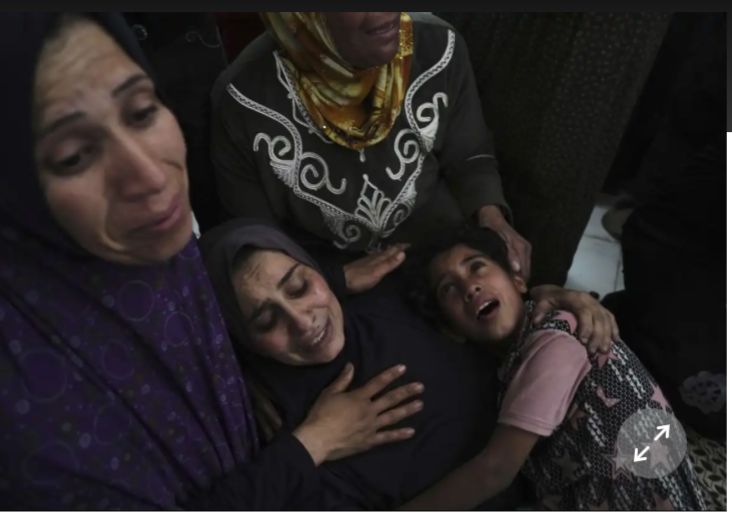Israel’s military operation in the Gaza Strip has intensified, with Defense Minister Yoav Gallant announcing a broader offensive aimed at seizing more territory and neutralizing militant threats. The announcement followed reports from local hospitals that over 40 people had been killed in overnight airstrikes, with nearly a dozen of the victims identified as children.
In a statement released Wednesday, Gallant declared that Israeli forces are expanding their ground campaign to “cleanse” militant elements and take control of large areas within Gaza. These newly seized territories, according to the defense minister, would eventually be incorporated into Israel’s expanded security zones. Although he did not specify the exact locations, the minister confirmed that the strategy involves mass evacuations of civilians from combat zones. This escalation comes on the heels of Israel’s recent order for the full evacuation of Rafah, the southern city that has become a refuge for hundreds of thousands of displaced Palestinians.
For years, Israel has maintained a buffer zone along the Gaza security fence, a measure it claims is necessary for national security. That buffer has grown considerably since the war began in October 2023. While Israeli officials frame the expansion as a protective move, Palestinians and international rights groups view it as an aggressive land grab that further diminishes the already narrow coastal enclave, home to approximately two million people.
Prime Minister Benjamin Netanyahu has reiterated that Israel intends to maintain indefinite security control over the Gaza Strip until Hamas is dismantled. The Israeli government continues to urge Gaza’s population to reject Hamas and demand the return of hostages. Currently, the militant group is believed to be holding 59 captives, with only 24 reportedly still alive. The rest have either been released or confirmed dead through ceasefire deals or intelligence reports.
Since the collapse of the ceasefire last month, Israel’s area of operation has significantly widened. The United Nations Office for the Coordination of Humanitarian Affairs reports that more than 60 percent of the Gaza Strip is now designated as “no-go” zones, rendering large swathes of the territory inaccessible to civilians and humanitarian workers alike. These restricted areas include a new military corridor that separates northern Gaza from the south, as well as expanded buffer zones and designated evacuation sectors.
The ongoing blockade imposed by Israel has further exacerbated the crisis. Humanitarian aid remains scarce, and the few organizations still operating in Gaza are struggling to deliver assistance amid the deteriorating security situation. Food, fuel, and medical supplies are all in critically short supply.
The growing urgency of the hostage situation has alarmed families and advocacy groups. The Hostage Families Forum, which represents most of the captives’ relatives, said it was “horrified” by Gallant’s announcement and urged the government to exhaust every diplomatic channel to secure the hostages’ release. The group warned that the captives are enduring increasingly dire conditions, including being chained, physically abused, and denied medical care. In a statement, the forum pleaded for immediate action to bring home both the living and the deceased, emphasizing that every additional day in captivity puts lives at further risk.
Meanwhile, the human toll in Gaza continues to rise. Israeli airstrikes in the southern city of Khan Younis overnight reportedly killed 17 people. A separate strike in northern Gaza claimed 15 more lives, according to local hospitals. Among the dead were women and children, including a pregnant woman. At the Jabaliya refugee camp, an Israeli strike on a building used by the UN Relief and Works Agency for Palestine Refugees (UNRWA) killed 15 people, most of them children and women. The building, originally an UNRWA clinic, had been converted into a shelter housing more than 700 displaced individuals. Despite warnings from UN staff about the vulnerability of the location, many families remained, having nowhere else to go.
Read Also:
- Arab leaders endorse $53bn counterproposal to Trump’s Gaza plan
- Trump meets with Jordan’s King Abdullah II, insists on Gaza plan
- U.S. supports Israel’s objective to eradicate Hamas in Gaza
UNRWA spokeswoman Juliette Touma confirmed that no agency staff were among the casualties but emphasized the humanitarian tragedy unfolding at the site. She described the strike as another example of the increasingly limited options for displaced families seeking safety within Gaza.
The Israeli military claimed responsibility for the strike, asserting that Hamas militants were using the site as a command and control center. This assertion has not been independently verified.
Elsewhere in Gaza, hospitals continued to report a rising number of casualties throughout the day. The European Hospital in Khan Younis received eight bodies on Wednesday, while Aqsa Hospital in central Gaza confirmed three more deaths linked to strikes in Zawaida.
The war, which began with a surprise Hamas-led attack on southern Israel on October 7, 2023, has now claimed the lives of more than 50,000 Palestinians, according to Gaza’s Health Ministry. Israeli sources maintain that around 20,000 of those killed were militants, although no verifiable breakdown has been provided. The same Hamas-led attack killed about 1,200 people in Israel and resulted in 251 hostages being taken.
As the war shows no signs of slowing, international concern continues to grow. Aid organizations are warning of a humanitarian collapse, families of hostages are pleading for resolution, and displaced civilians remain trapped between airstrikes and limited humanitarian corridors.
This escalating crisis reflects not only the deepening devastation in Gaza but also a broader geopolitical reckoning for the region — one where military goals, humanitarian obligations, and public pressure are colliding with ever greater urgency.



